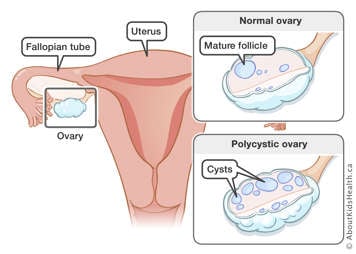Polycystic ovary syndrome (PCOS) is a condition that can affect girls undergoing puberty. Girls with PCOS suffer from hormone imbalance. Their ovaries tend to produce unusually high amounts of certain hormones called androgens.
The ovaries are two small organs that belong to the female reproductive system and are located on either side of the belly. They contain eggs and release hormones.
Girls with PCOS may have enlarged ovaries because they contain many cysts (sacs filled with fluid). Teenage girls and women with PCOS often have insulin resistance, which typically causes the pancreas to produce more insulin than normal. Increased insulin can cause weight gain, which is a factor in the development of both PCOS and type 2 diabetes. The cause of PCOS is not well understood.

In Canada, PCOS was found in 12% of children and youth diagnosed with type 2 diabetes.
For information on signs and symptoms, diagnosis and treatment, read our Health A-Z on PCOS.